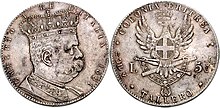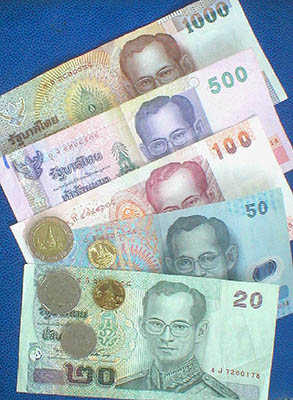
The baht is the official currency of Thailand. It is divided into 100 satang. The issuance of currency is the responsibility of the Bank of Thailand. SWIFT ranked the Thai baht as the 10th-most-frequently used world payment currency as of January 2019.
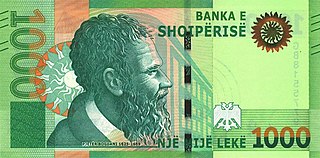
The lek is the currency of Albania. Historically, it was subdivided into 100 qintars.
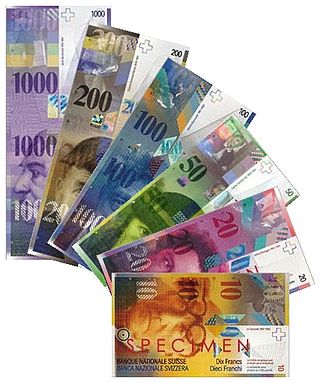
The Swiss franc is the currency and legal tender of Switzerland and Liechtenstein. It is also legal tender in the Italian exclave of Campione d'Italia which is surrounded by Swiss territory. The Swiss National Bank (SNB) issues banknotes and the federal mint Swissmint issues coins.
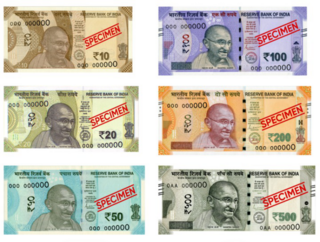
The Indian rupee is the official currency in the Republic of India. The rupee is subdivided into 100 paise. The issuance of the currency is controlled by the Reserve Bank of India. The Reserve Bank manages currency in India and derives its role in currency management on the basis of the Reserve Bank of India Act, 1934.

The Maria Theresa thaler (MTT) is a silver bullion coin and a type of Conventionsthaler that has been used in world trade continuously since it was first minted in 1741. It is named after Maria Theresa who ruled Austria, Hungary, and Bohemia from 1740 to 1780 and is depicted on the coin.

The birr is the primary unit of currency in Ethiopia. It is subdivided into 100 santims.

The lira was the currency of Italy between 1861 and 2002. It was first introduced by the Napoleonic Kingdom of Italy in 1807 at par with the French franc, and was subsequently adopted by the different states that would eventually form the Kingdom of Italy in 1861. It was subdivided into 100 centesimi, which means "hundredths" or "cents". The lira was also the currency of the Albanian Kingdom from 1941 to 1943.

The krone was the official currency of Austria-Hungary from 1892 until the dissolution of the empire in 1918. The subunit was one hundredth of the main unit, and was called a Heller in the Austrian and a fillér in the Hungarian part of the Empire.

The nakfa is the currency of Eritrea and was introduced on 15 November 1998 to replace the Ethiopian birr at par. The currency takes its name from the Eritrean town of Nakfa, site of the first major victory of the Eritrean War of Independence. The nakfa is divided into 100 cents.

The Manchukuo yuan was the official unit of currency of the Empire of Manchuria, from June 1932 to August 1945.

The East African shilling was the sterling unit of account in British-controlled areas of East Africa from 1921 until 1969. It was issued by the East African Currency Board. It is also the proposed name for a common currency that the East African Community plans to introduce.
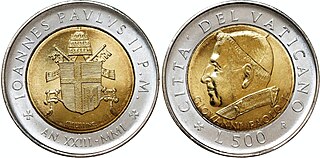
The lira was the currency of the Vatican City between 1929 and 2002. It was not a separate currency but an issue of the Italian lira; the Banca d'Italia produced coins specifically for Vatican City.

The lira was the currency of San Marino from the 1860s until it was replaced by the euro on 1 January 2002. It was equivalent and pegged to the Italian lira. Italian coins and banknotes and Vatican City coins were legal tender in San Marino, while Sammarinese coins, minted in Rome, were legal tender throughout Italy, as well as in the Vatican City.

The Somalo was the currency of the Trust Territory of Somaliland administered by Italy between 1950 and 1960. The "Somalo" remained officially in use in the newly created Somali Republic until 1962. It was subdivided into 100 centesimi.

The lira AOI was a special banknote circulating in Italian East Africa between 1938 and 1941.

The Somali rupia was the currency in Italian Somaliland from 1909 to 1925. It was subdivided into 100 bese.
The lira was the distinct currency of Venice until 1848, when it was replaced by the Italian lira. It originated from the Carolingian monetary system used in much of Western Europe since the 8th century CE, with the lira subdivided into 20 soldi, each of 12 denari.

The Italian Somaliland lira also called the Somali lira, was a special version of the Italian lira minted in Italian Somaliland between 1925 and 1926.

The AM-lira was the currency issued in Italy by Allied Military Government for Occupied Territories (AMGOT) after the Allied invasion of Sicily in 1943. 100 AM-lire were worth 1 US dollar.
Italy has a long history of different coinage types, which spans thousands of years. Italy has been influential at a coinage point of view: the florin, one of the most used coinage types in European history, was struck in Florence in the 13th century. Since Italy has been for centuries divided into many city-states, they all had different coinage systems, but when the country became unified in 1861, the Italian lira came into place, and was used until 2002. Today, Italy uses the euro.
